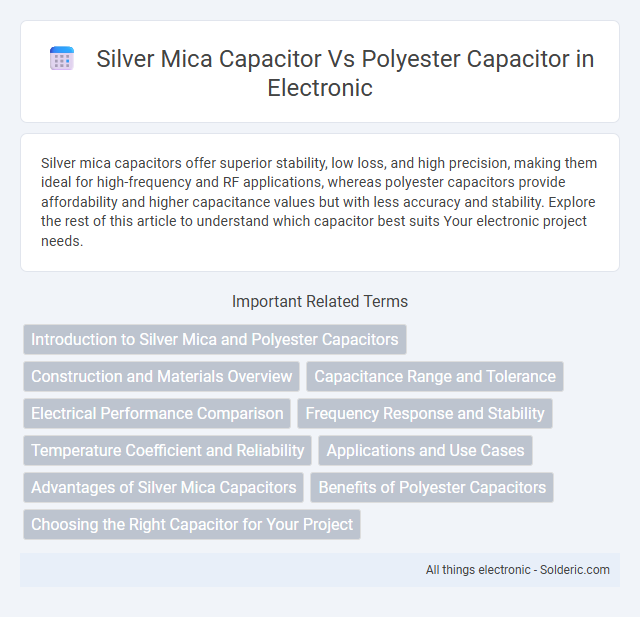Silver mica capacitors offer superior stability, low loss, and high precision, making them ideal for high-frequency and RF applications, whereas polyester capacitors provide affordability and higher capacitance values but with less accuracy and stability. Explore the rest of this article to understand which capacitor best suits Your electronic project needs.
Comparison Table
| Feature | Silver Mica Capacitor | Polyester Capacitor |
|---|---|---|
| Dielectric Material | Silver mica | Polyester (PET) |
| Capacitance Range | 1 pF to 0.1 mF | 10 pF to 10 mF |
| Tolerance | +-1% to +-5% | +-5% to +-20% |
| Temperature Stability | Excellent (-55degC to +125degC) | Good (-55degC to +85degC) |
| Dielectric Loss | Very low | Moderate |
| Voltage Rating | Up to 1000 V | Up to 400 V |
| Physical Size | Small and compact | Larger for same capacitance |
| Applications | High frequency circuits, RF tuning | General purpose, filtering, coupling |
| Cost | Higher | Lower |
Introduction to Silver Mica and Polyester Capacitors
Silver mica capacitors are precision components known for their ultra-low loss, stable capacitance, and excellent temperature stability, making them ideal for high-frequency applications and RF circuits. Polyester capacitors, also called PET capacitors, provide good electrical characteristics with moderate stability and low cost, widely used in general-purpose electronic circuits like filtering, timing, and coupling. Both types differ significantly in dielectric material, tolerance, temperature coefficient, and reliability, affecting their suitability across various electronic designs.
Construction and Materials Overview
Silver mica capacitors consist of thin mica sheets coated with silver, providing exceptional stability and low loss, while polyester capacitors use a plastic film dielectric made from polyethylene terephthalate (PET) with aluminum foil electrodes. The rigid, inorganic mica structure in silver mica capacitors offers superior temperature tolerance and precision, contrasting with the flexible, polymer-based construction of polyester capacitors that favors compactness and cost efficiency. Your application's performance requirements guide the choice, as silver mica excels in high-frequency and high-precision circuits, whereas polyester capacitors are suitable for general-purpose and low-frequency uses.
Capacitance Range and Tolerance
Silver mica capacitors typically offer a capacitance range from 1 pF to 0.1 uF with very tight tolerance levels often as low as +-1%, ensuring stable performance in precision circuits. Polyester capacitors, on the other hand, generally cover a broader capacitance range from 100 pF up to several microfarads but have wider tolerance values around +-5% to +-10%. Your choice depends on whether precise capacitance stability or higher capacitance values are more critical for your application.
Electrical Performance Comparison
Silver mica capacitors exhibit superior electrical performance with low dielectric loss, high stability, and excellent temperature coefficients, making them ideal for high-frequency applications. Polyester capacitors, while more cost-effective, have higher dielectric absorption and less temperature stability, limiting their use in precision circuits. Silver mica's consistent capacitance over a wide temperature range ensures reliable operation in RF circuits compared to the more variable behavior of polyester capacitors.
Frequency Response and Stability
Silver mica capacitors exhibit superior frequency response and exceptional stability due to their low dielectric loss and tightly controlled capacitance values, making them ideal for high-frequency applications up to several hundred MHz. Polyester capacitors have higher dielectric losses and less stable capacitance under varying temperature and voltage conditions, limiting their effective use to lower-frequency circuits typically below a few hundred kHz. The inherent material properties of silver mica provide minimal signal distortion and superior performance in RF and microwave circuits compared to polyester capacitors.
Temperature Coefficient and Reliability
Silver mica capacitors exhibit a lower temperature coefficient, typically around 50-100 ppm/degC, ensuring greater capacitance stability across temperature variations compared to polyester capacitors, which have a higher temperature coefficient of approximately 200-400 ppm/degC. The inherent construction of silver mica capacitors provides superior reliability and long-term stability, making them ideal for precision applications subjected to wide temperature ranges. Polyester capacitors tend to exhibit increased dielectric losses and degradation over time when exposed to high temperatures, reducing their overall lifespan and reliability in demanding environments.
Applications and Use Cases
Silver mica capacitors excel in high-frequency applications and precision circuits such as RF transmitters, oscillators, and filters due to their low loss and high stability. Polyester capacitors are commonly used in audio equipment, coupling, and timing circuits where moderate stability and higher capacitance values are needed at a lower cost. Both capacitors serve distinct roles in electronics, with silver mica preferred in demanding environments and polyester favored for cost-effective, general-purpose applications.
Advantages of Silver Mica Capacitors
Silver mica capacitors offer superior stability and precision with low tolerance values, making them ideal for high-frequency applications and RF circuits. Their excellent temperature coefficient ensures minimal capacitance variation under thermal stress, unlike polyester capacitors which exhibit higher leakage and dielectric absorption. These characteristics result in consistent performance and long-term reliability, especially in timing and tuning circuits.
Benefits of Polyester Capacitors
Polyester capacitors offer excellent stability and reliability in various electrical applications due to their high dielectric constant and low dissipation factor. These capacitors provide superior moisture resistance and better voltage handling compared to silver mica capacitors, making them ideal for environments with fluctuating temperatures and humidity. Your circuits benefit from the cost-effectiveness and versatile performance of polyester capacitors, especially in filtering, timing, and coupling applications.
Choosing the Right Capacitor for Your Project
Silver mica capacitors offer superior temperature stability and low loss characteristics, making them ideal for high-frequency and precision applications such as RF circuits and oscillators. Polyester capacitors provide higher capacitance values at a lower cost with good electrical stability, suitable for general-purpose circuits, filtering, and timing applications. Selecting the right capacitor depends on project requirements for tolerance, frequency response, temperature stability, and budget constraints.
silver mica capacitor vs polyester capacitor Infographic

 solderic.com
solderic.com